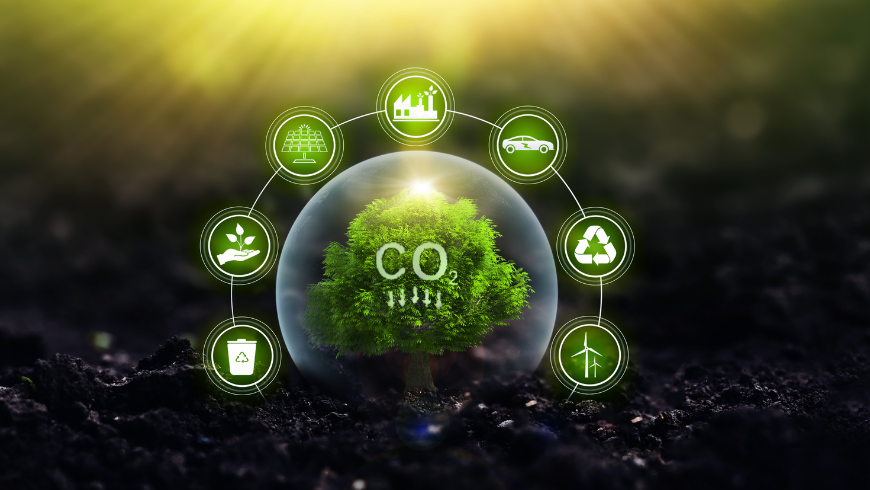The urgent need to address climate change has propelled technological innovations aimed at tracking and reducing carbon emissions to the forefront of global efforts. As the impacts of global warming become evident, from rising sea levels to extreme weather events, the development and deployment of these technologies are crucial for mitigating environmental damage and ensuring a sustainable future. This article explores some of the most promising technological advancements in tracking and reducing carbon emissions, highlighting their potential impact and the challenges that remain.
The Importance of Carbon Tracking

Accurate tracking of carbon emissions is the first step in the fight against climate change. Without precise data, it is impossible to set effective reduction targets or measure progress. Innovations in carbon tracking technologies have improved our ability to check emissions from various sources, including industrial facilities, transportation, and agriculture.
Satellite Monitoring
Satellites equipped with advanced sensors are revolutionizing carbon tracking. Organizations like NASA and the European Space Agency (ESA) have launched satellites capable of measuring carbon dioxide (CO2) and methane (CH4) concentrations in the atmosphere with unprecedented accuracy. These satellites provide real-time data on greenhouse gas emissions, enabling scientists and policymakers to identify emission hotspots and track changes over time.
Internet of Things (IoT) Devices
The proliferation of IoT devices has enabled more granular monitoring of carbon emissions. Smart sensors installed in factories, power plants, and vehicles can measure emissions and send data to central systems for analysis. This real-time monitoring allows for quick identification of inefficiencies and prompt corrective actions, reducing emissions.
Blockchain for Carbon Tracking
Blockchain technology is emerging as a powerful tool for ensuring transparency and accountability in carbon tracking. By creating immutable records of emissions data, blockchain can help verify the accuracy of reported emissions and prevent fraud. This is particularly important for carbon trading schemes, where accurate tracking is essential for ensuring the integrity of the market.
Innovations in Carbon Reduction

While tracking emissions is crucial, it is important to develop technologies that reduce carbon emissions. Several innovative approaches are being explored to capture, store, and use carbon, as well on reduce emissions at their source.
Direct Air Capture (DAC)
Direct Air Capture is a cutting-edge technology that involves extracting CO2 directly from the atmosphere. Companies like Climeworks and Carbon Engineering have developed systems that use chemical processes to capture CO2, which can then be stored or used to produce synthetic fuels. Although DAC is still in the early stages of commercialization, it holds promise as a method for removing CO2 from the atmosphere on a large scale.
Carbon Capture and Storage (CCS)
CCS technology involves capturing CO2 emissions from industrial processes and power generation and storing them underground in geological formations. Advances in this field have made it possible to capture up to 90% of CO2 emissions from some sources. Pilot projects, such as the Boundary Dam Power Station in Canada and the Petra Nova project in the United States, have demonstrated the potential of CCS to reduce emissions from fossil fuel-based power plants.
Renewable Energy Technologies
The transition to renewable energy sources is essential for reducing carbon emissions from power generation. Innovations in solar, wind, and hydroelectric power technologies have made these sources more efficient and cost-effective. Solar photovoltaic (PV) cells, for example, have seen significant improvements in efficiency and reductions in cost, making solar power a viable alternative to fossil fuels. Similarly, advancements in wind turbine design have increased energy output and reduced maintenance costs.
Energy Storage Solutions
Renewable energy sources are intermittent, so effective energy storage solutions are critical for ensuring a reliable supply of clean energy. Innovations in battery technology, such as lithium-ion and solid-state batteries, are enhancing the capacity and efficiency of energy storage systems. These advancements enable the storage of excess energy generated during peak production periods for use when renewable sources are not available, thereby reducing reliance on fossil fuels.
Electrification of Transportation
The transportation sector is a major contributor to global carbon emissions. Electrifying transportation, from personal vehicles to public transit and freight, is a key strategy for reducing these emissions. Advances in electric vehicle (EV) technology, including improvements in battery efficiency and charging infrastructure, are making EVs more accessible and practical for consumers. Additionally, the development of electric planes and ships is opening new avenues for reducing emissions in aviation and maritime transport.
Green Hydrogen
Hydrogen produced using renewable energy, known as green hydrogen, is emerging as a versatile and clean energy carrier. Green hydrogen can be used in various applications, from powering fuel cells in vehicles to providing heat for industrial processes. Technological innovations in electrolysis, the process of splitting water into hydrogen and oxygen using electricity, are making green hydrogen production more efficient and cost-effective.
Sustainable Agriculture Practices
Agriculture is another significant source of carbon emissions, due to methane from livestock and nitrous oxide from fertilizers. Technological innovations in sustainable agriculture practices can help reduce these emissions. Precision farming techniques, which use data and technology to optimize crop yields and cut inputs, are reducing the carbon footprint of agriculture. Additionally, advances in alternative proteins, such as lab-grown meat and plant-based substitutes, are providing low-carbon alternatives to traditional animal agriculture.
Challenges and Future Directions
While technological innovations for tracking and reducing carbon are promising, several challenges remain. The high cost of some technologies, such as DAC and green hydrogen production, is a significant barrier to widespread adoption. Furthermore, the development and deployment of these technologies must large investment and supportive policies.
Another challenge is the need for global cooperation. Climate change is a global problem that requires coordinated efforts across countries and sectors. International agreements, such as the Paris Agreement, provide a framework for cooperation, but effective implementation requires commitment and action from all parties.
Looking ahead, continued investment in research and development is essential for advancing these technologies and making them more accessible. Public and private sector collaboration will be key to scaling up deployment and achieving meaningful reductions in carbon emissions. Education and awareness campaigns can also play a role in driving behavioral changes and increasing public support for climate action.
In conclusion, technological innovations in tracking and reducing carbon emissions are critical for addressing the urgent challenge of climate change. From satellite monitoring and blockchain for carbon tracking to CCS, DAC, and renewable energy technologies, these advancements offer promising solutions for reducing our carbon footprint. But, overcoming the challenges associated with cost, investment, and global cooperation will be essential for realizing the full potential of these technologies and securing a sustainable future for generations to come.



